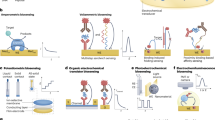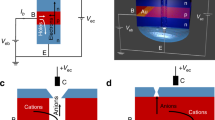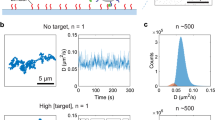Abstract
Biosensors are molecular sensors that combine a biological recognition mechanism with a physical transduction technique. They provide a new class of inexpensive, portable instrument that permit sophisticated analytical measurements to be undertaken rapidly at decentralized locations1. However, the adoption of biosensors for practical applications other than the measurement of blood glucose is currently limited by the expense, insensitivity and inflexibility of the available transduction methods. Here we describe the development of a biosensing technique in which the conductance of a population of molecular ion channels is switched by the recognition event. The approach mimics biological sensory functions2,3 and can be used with most types of receptor, including antibodies and nucleotides. The technique is very flexible and even in its simplest form it is sensitive to picomolar concentrations of proteins. The sensor is essentially an impedance element whose dimensions can readily be reduced to become an integral component of a microelectronic circuit. It may be used in a wide range of applications and in complex media, including blood. These uses might include cell typing, the detection of large proteins, viruses, antibodies, DNA, electrolytes, drugs, pesticides and other low-molecular-weight compounds.
This is a preview of subscription content, access via your institution
Access options
Subscribe to this journal
Receive 51 print issues and online access
$199.00 per year
only $3.90 per issue
Buy this article
- Purchase on Springer Link
- Instant access to full article PDF
Prices may be subject to local taxes which are calculated during checkout




Similar content being viewed by others
References
Scheller, F. W., Schubert, F. & Fedrowitz, J. (eds) Frontiers in Biosensorics Vols I & II(Birkhauser, Berlin, (1996)).
Avrone, E. & Rospars, J. P. Modelling insect olfactory neurone signaling by a network utilising disinhibition. Biosystems 36, 101–108 (1995).
Reiken, S. R. et al. Bispecific antibody modification of nicotine acetycholine receptors for biosensing. Biosens. Bioelectron. 11, 91–102 (1996).
Koeppe, R. E. & Andersen, O. S. Engineering the gramicidin channel. Annu. Rev. Biophys. Biomol. Struct. 25, 231–258 (1996).
McConnell, H. M., Watts, T. H., Weis, R. M. & Brian, A. A. Supported planar membranes in studies of cell-cell recognition in the immune system. Biochim. Biophys. Acta 864, 95–106 (1986).
Florin, E.-L. & Gaub, H. E. Painted supported lipid membranes. Biophys. J. 64, 375–383 (1993).
Lang, H., Duschl, C. & Vogel, H. Anew class of thiolipids for the attachment of lipid bilayers on gold surfaces. Langmuir 10, 197–210 (1994).
Steizle, M., Weismuller, G. & Sackmann, E. On the application of supported bilayers as receptive layers for biosensors with electrical detection. J. Phys. Chem. 97, 2974–2981 (1993).
Plant, A. L., Gueguetchkeri, M. & Yap, W. Supported phospholipid/alkanethiol biomimetic membranes: insulating properties. Biophys. J. 67, 1126–1133 (1994).
Folkers, J. P., Laibinis, P. E., Whitesides, G. M. & Deutch, J. Phase behaviour of two-component self-assembled monolayers of alkanethiolates on gold. J. Phys. Chem. 98, 563–571 (1994).
Steinem, C., Janschoff, A., Ulrich, W. P., Sieber, M. & Galla, H. J. Impedance analysis of supported lipid bilayer membranes: a scrutiny of different preparation techniques. Biochem. Biophys. Acta 1279, 169–180 (1996).
Lu, X. D., Ottova, A. L. & Tien, H. T. Biophysical aspects of agar-gel supported bilayer lipid membranes: a new method for forming and studying planar bilayer lipid membranes. Bioelectrochem. Bioenerget. 39, 285–289 (1996).
Heysel, S., Vogel, H., Sanger, M. & Sigrist, H. Covalent attachment of functionalised lipid bilayers to planar waveguides for measuring protein binding to biomimetic membranes. Protein Sci. 4, 2532–2544 (1995).
Rickert, J., Weiss, T., Kraas, W., Jung, G. & Gopel, W. Anew affinity biosensor: self-assembled thiols as selective monolayer coatings of quartz crystal microbalances. Biosens. Bioelectron. 11, 591–598 (1996).
Sackmann, E. Supported membranes: scientific and practical applications. Science 271, 43–48 (1996).
Stetter, K. O. Hypothermophilic procaryotes. FEMS Microbiol. Rev. 18, 149–158 (1996).
Hladky, S. B., Leung, J. C. H. & Fitzgerald, W. The mechanism of ion conduction by valinomycin-analysis of charge pulse responses. Biophys. J. 69, 1758–1772 (1995).
Nikolelis, D., Siontorou, C. G., Krull, U. J. & Katrivanos, P. L. Ammonium ion minisensors from self-assembled bilayer lipid membranes using gramicidin as an ionophore. Modulation of ammonium selectivity by Platelet Activating Factor. Anal. Chem. 68, 1735–1741 (1996).
Acknowledgements
This work was supported by the Australian Industrial Research & Development Board and the Cooperative Research Centres (CRC) program. The partner organisations within the CRC for Molecular Engineering & Technology are the Commonwealth Scientific & Industrial Research Organisation, the University of Sydney and the Australian Membrane & Biotechnology Research Institute.
Author information
Authors and Affiliations
Corresponding author
Supplementary information
Rights and permissions
About this article
Cite this article
Cornell, B., Braach-Maksvytis, V., King, L. et al. A biosensor that uses ion-channel switches. Nature 387, 580–583 (1997). https://doi.org/10.1038/42432
Received:
Accepted:
Issue Date:
DOI: https://doi.org/10.1038/42432
This article is cited by
-
Assembly of transmembrane pores from mirror-image peptides
Nature Communications (2022)
-
AI-based atomic force microscopy image analysis allows to predict electrochemical impedance spectra of defects in tethered bilayer membranes
Scientific Reports (2022)
-
A Review on the Size-Dependent Models of Micro-beam and Micro-plate Based on the Modified Couple Stress Theory
Archives of Computational Methods in Engineering (2022)
-
Complementary energy principle associated with modified couple stress theory for Euler micro-beams considering support movements and negative Poisson's ratio
Archive of Applied Mechanics (2022)
-
Rational Design of Biomolecules/Polymer Hybrids by Reversible Deactivation Radical Polymerization (RDRP) for Biomedical Applications
Chinese Journal of Polymer Science (2021)
Comments
By submitting a comment you agree to abide by our Terms and Community Guidelines. If you find something abusive or that does not comply with our terms or guidelines please flag it as inappropriate.



